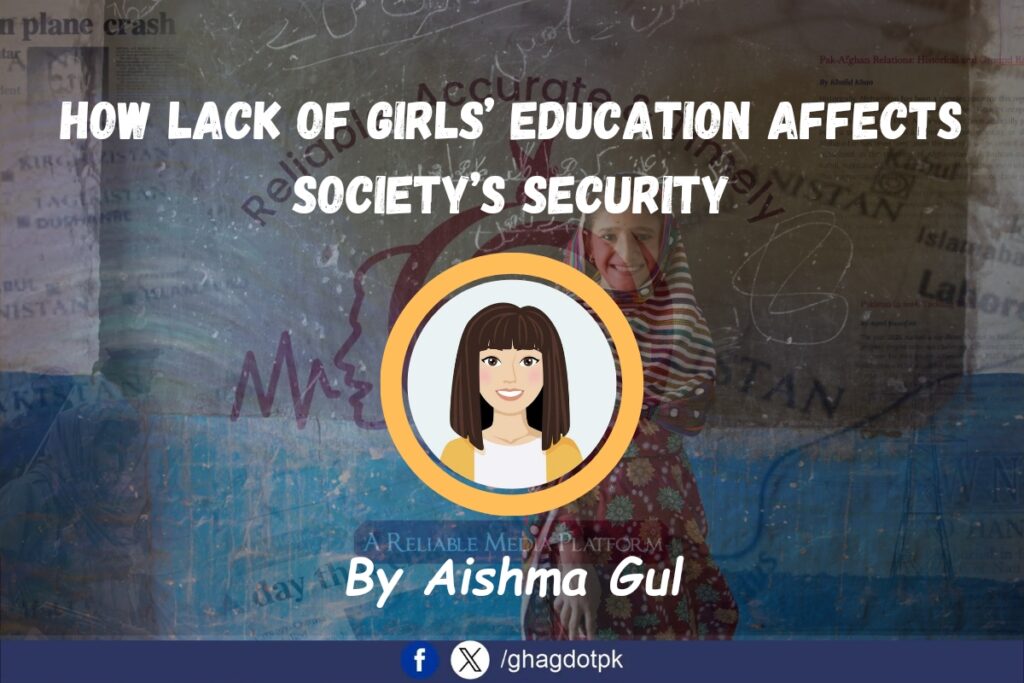By Aishma Gul
In the words of Malala Yousafzai, “One child, one teacher, one book, and one pen can change the world.” Yet, in Pakistan, the alarming lack of girls’ education poses profound challenges not just to societal progress but also to national security.
Women account for almost half of the population but the female literacy rate is alarming 49%, more than 12 million girls are out of school. These numbers are made worse by systemic failures in governance, as observed in Khyber Pakhtunkhwa (KP), where only 13% of the development budget for the fiscal year 2024-25 has actually been spent. The provincial government’s focus on political protests and federal quarrels have overshadowed pressing problems like education, adding to the crisis.
The risks of inaction on girls’ education are deep and wide. Educated girls grow into mothers who raise future generations, and girls missing those classrooms today means poverty, violence and insecurity in society tomorrow. This urgent call to action is reinforced by Pakistan’s almost 24 million out-of-school children, more than half of them girls. It perpetuates a cycle that stunts the growth of society and exacerbates the factors that give rise to extremism and unrest.
Challenges Hindering Girls’ Education
Several deeply rooted barriers prevent girls from accessing education in Pakistan. Economic disparities, social taboos, and logistical challenges disproportionately affect female students, particularly in tribal regions like KP and Balochistan. Many families prioritize sons over daughters when resources are scarce, further widening the gender gap. Poverty drives millions of girls out of school, while early marriages and societal pressures seal their futures away from education.
Additionally, infrastructure gaps like distant schools, poor transport safety and insufficient care facilities add to the challenges faced. Families are also deterred from sending their daughters to school out of fear of harassment, as the schools have no female teachers. These challenges are especially acute in rural and tribal areas where patriarchal traditions and misinformation about girls’ education prevail.
The high dropout rates after matriculation highlight another glaring issue: the absence of higher educational institutions for girls. This scenario, in conjunction with socio-economic injustices, allows little space for young women to pick up on their dreams. In KP, for example, this neglect is aggravated by the underutilization of development funds by the government, as the education sector spends only 14% of its budget allocation.
The Link Between Girls’ Education and Security
It has been said that educating girls is not just a development target; it’s a cornerstone of national security. Education promotes social bonding and decreases poverty, as studies have shown, and makes communities stronger. According to the theories and studies, an educated mother is more likely to raise children who contribute positively to society. In contrast, mothers with little education, largely oblivious of the significance of parenting elements such as discipline, empathy, and higher-order thinking skills, may unknowingly create breeding grounds for violence or extremism.
Low literacy rates have also allowed extremist groups like the Tehrik-i-Taliban Pakistan (TTP) to prey on communities, recruiting individuals who largely lack the education or critical-thinking capacity to reject radical belief systems. Studies published by the Global Partnership for Education show that with every extra year of schooling, the chances of conflict decrease by 20 percent. It highlights the significance of education in promoting stability and dispelling the seeds of insecurity.
Governance and Budget Utilization
The failure of governance further compounds these challenges. The fiscal budget 2024-25 of the KP government presents PKR 416 billion for development in settled and tribal districts. But only 13 percent of this budget was spent in the first half of this year, with education seeing just 14 percent of its allocation. This neglect can be traced to the provincial government’s preoccupation with political protests.
While protests dominate the political landscape, critical sectors like education are sidelined, leaving school-age children, especially girls, without access to quality education. Most departments in KP have spent less than 10% of their allocated funds, raising serious concerns about priorities and governance. The unspent funds could have been used to address key issues like building schools in underserved areas, providing transportation for students, and training more female teachers to make education accessible and safe for girls.
Breaking the Cycle
The lack of girls’ education perpetuates a vicious cycle of poverty, ignorance, and insecurity. Educated women are vital for building resilient communities. Not only do they add to the economy, but they are also essential to peace and stability. Educated women can question societal constructions, stand up for their rights, and raise children who value compassion and critical thinking.
The government must prioritize education by fully utilizing allocated budgets and focusing on initiatives that directly impact girls’ education. This includes constructing schools in remote areas, ensuring safe transportation, and providing sanitary facilities. Public awareness campaigns must also be undertaken to destigmatize as well as highlight the importance of educating girls.
The absence of education for girls is not just a developmental failure but a security risk that Pakistan cannot afford to ignore. Educating girls is not only a moral imperative, it is also a strategic necessity. Investing in education can do wonders for Pakistan, it can lead to a generation that prefers peace and strength over instability and terrorism. To quote Quaid-e-Azam Muhammad Ali Jinnah, “No nation can rise to the height of glory unless your women are side by side with you.”






